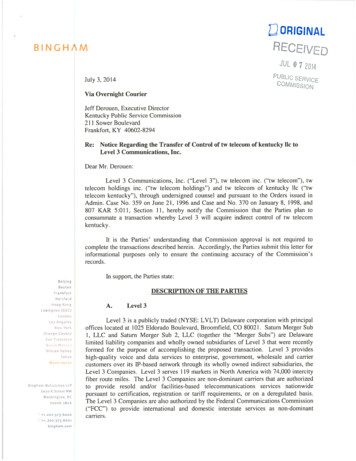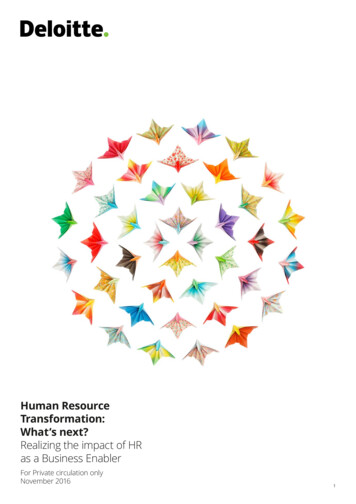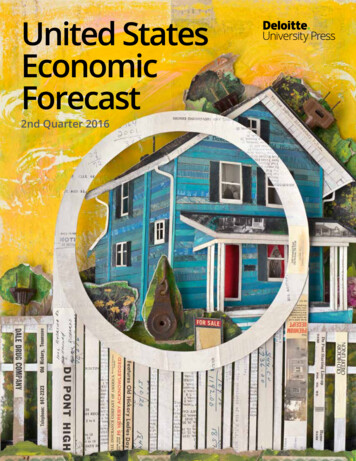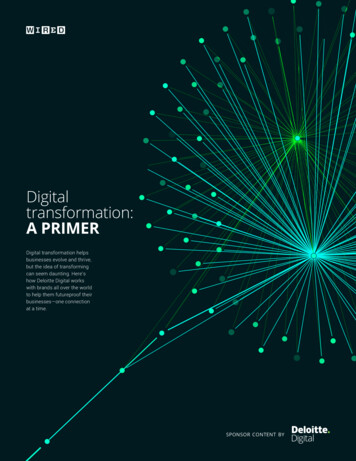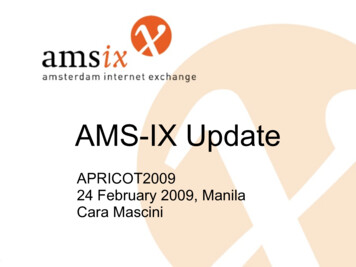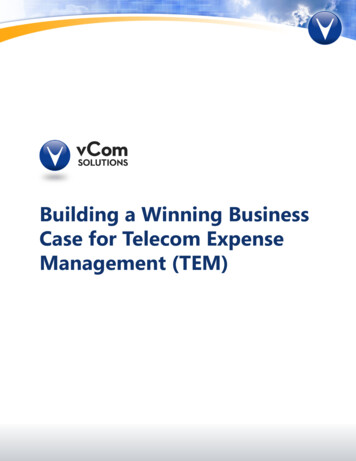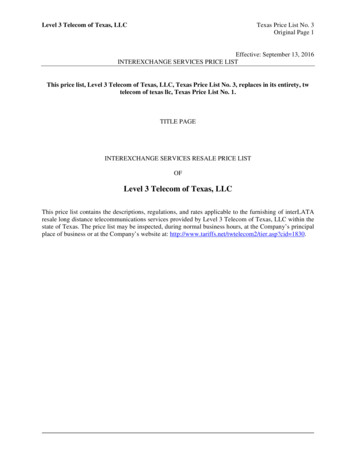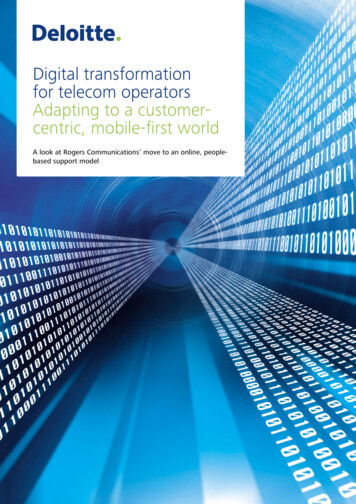
Transcription
Digital transformationfor telecom operatorsAdapting to a customercentric, mobile-first worldA look at Rogers Communications’ move to an online, peoplebased support model
ContentsAbstract 1People’s use of mobile continues to expand and evolve 2The digital challenge for telecom operators 4The role of digital in customer-led transformation 5Key learnings 7Authors and Contacts 8Endnotes 9This report is written by Deloitte MCS Limited (‘Deloitte’) in collaboration with Facebook Inc. and RogersCommunications Inc. It utilizes Deloitte survey data and anonymized Facebook users’ and Rogers’ customerdata. The content of this report is not intended to be relied upon and should not be interpreted as specificadvice.
AbstractThe rapid growth and use of smartphones has changedcustomer behavior and their expectations interacting withdifferent business providers. Businesses must consideradapting their organization and channels through whichthey engage with and support customers in order to meettheir evolving needs.Embracing ‘over the top’ (OTT) services such as instantmessaging platforms offers one such mechanism toengage with customers. Such platforms can meetindividual, people-based needs and provide both partieswith a fast and convenient channel through which theycan interact with one another.In light of these trends, this paper discusses how RogersCommunications has adopted an array of online tools,apps and people-based platforms, such as FacebookMessenger service, to meet rising customer expectationsand transform into a more customer-centric organization.Digital transformation for telecom operators Adapting to a customer-centric, mobile-first world1
People’s use of mobile continues toexpand and evolveEach year the mobile phone becomes more ubiquitous and pervasive. In many countries it is not just the typicalcommunications mode, it is also people’s only personal computing device – their only means of connecting withthe rest of the world. A wide range of organizations have enabled the shift to mobile, but the most critical has beenthe network operator. From their initial investments in cellular radio in the 1980s and 1990s through to the roll outof third and fourth generation mobile broadband and the deployment of Wi-Fi in homes and hotspots, networkoperators are, and remain, a crucial player in the connected economy.The role of mobile technology in people’s lives is becoming even more significant as we transition into a DigitalEconomy. For example, in 2015 Canadian users spent over two hours a day using non-voice features of their phones,more than double the same statistic in 2012.1 Additionally, forecasters anticipate that tens of billions more deviceswill come online and become connected by 2020.2,3,4 This near-future universal connectivity is likely to give peopleon-demand access to and control over entertainment and shopping like never before. As a frame of reference, thetop apps people currently download come from entertainment, communication and retail.Figure 1. Forecast growth of connected objects, 4201420152016201720182019Source: Connection Counters: The Internet of Everything in Motion, CiscoThe role of mobile technology in people’s lives isbecoming even more significant as we transition into aDigital Economy.22020
Collectively, these mega trends of universal connectivity and increased control over commerce and services havefundamentally changed customer needs and behaviors. Mobile customers now desire (and prefer) immediacy,interacting with products and services wherever they are and whenever they want.The increased availability and immediacy of information enabled by digital and mobile technology means peopleexpect greater personalization and agility from businesses, and because personalization breeds trust, this becomesan increasingly critical factor in people’s decision making. Today’s consumers want all of the information – the good,bad and ugly – so they can decide for themselves.5A Deloitte survey on personalization suggests that younger consumers are more comfortable sharing personalinformation with businesses compared to the general population. 20 per cent of consumers are happy for businessesto use their personal information to offer them personalized products and services. This figure increases to over25 per cent amongst 16 – 24 year olds.6Given the close correlation between trust, loyalty and advocacy, businesses need to demonstrate to consumers thebenefits of sharing their personal data by offering them more personalized products and services. In tandem, theymust also continue to reassure consumers that appropriate governance is in place to protect their personal data.Our research shows that only20 per cent of consumersare happy for businesses to use their personalinformation to offer them more personalizedproducts or services.Among 16 to 24 year olds thisgoes up tomore than25 per centDigital transformation for telecom operators Adapting to a customer-centric, mobile-first world3
The digital challenge for telecomoperatorsThe technological capabilities operators have enabled, along with the evolution of people’s preferences, have raisedexpectations across two key areas: Commerce – 60 per cent of omni-channel shoppers are increasing the volume of purchases made on theirsmartphone.7 Account management and support – people prefer reaching brands online vs. the phone.8The task of providing the desired level of immediacy and agility in commerce and service is made more challengingfor telecom companies by the increasing breadth and complexity of their business. Consolidation in many marketsbetween organizations that have traditionally occupied separate market verticals, such as fixed line, broadband,broadcasting and content has increased the variety of customer archetypes in the base. This will only get morecomplex as new types of connected devices such as cars and connected homes enter the mass market.Responding to the twin challenge of evolving customer expectations and rapidly changing mobile technologyrequires telecom companies to embrace some key cultural and strategic characteristics of Digital Economy businessesin order to better reflect their market.Consumers now (sometimes unknowingly) expect more personalization in their lifecycle with businesses. Mobileoperators therefore need to adapt to people’s behavior on mobile, across their customers’ lifecycle with them,rather than forcing their customers to correspond to their traditional portfolio of services and channels (e.g. throughcalls or in-store visits).Increasing personalization may entail decoupling those people and technologies that touch the customer from theback-office and network technology. This alone represents a transformational challenge.The other challenge is how to create an environment to innovate and fail faster in order to change their businessmodels and how consumers view them. An industry example of this is AT&T’s Emerging Devices Organization (EDO).Characterized as a ‘start up within the larger organization’, the EDO was formed to quickly identify and create newbusiness models within the broader mobile ecosystem.9 By enabling this kind of culture of innovation, operators willbe able to more effectively launch and assess new ventures as well as humanize their brand, which bodes well in thisera of personalization.Importantly, operators must embrace something they know to be true already: they must recognize and optimizetheir participation in the digital ecosystem. This means understanding that people are increasingly in control oftheir experiences on mobile and are making choices from an array of providers. Some will want simplicity; others willwant to optimize for their particular preferences. To that end, it would be overly simplistic for operators to regardthe emergence of OTT services as just a threat. People clearly enjoy using these services and have begun to graduallyevolve their behaviors to emphasize their use. Leading operators have already taken steps to benefit from the role ofOTTs by using the engaging channels they offer to deepen their relationship with consumers in all parts of the salesand service cycle.In the following section we describe how Rogers Communications of Canada used an array of online tools includingapps and large, people-based platforms such as Facebook Messenger (which, as of January 2016, 800 million peopleglobally use each month10) to measurably enhance customer satisfaction.Importantly, operators must embrace something theyknow to be true already: they must recognize andoptimize their participation in the digital ecosystem.4
The role of digital in customer-ledtransformationCanada is a highly mobile-connected market. 70 per cent of people have access to at least one smartphone andmore than half of these devices were purchased within the last 18 months.11 In 2015, Canada recorded the fastestaverage 4G connection speed across the G7 economies.12Access to cutting-edge devices operating on high speed networks enables sophisticated consumption behaviors.Onethird (36 per cent) of Canadians use instant messaging apps at least once a week, with women far more likely(45 per cent) than men (26 per cent) to do so. 17 per cent of people indicated they used instant messaging morefrequently in 2015 than in 2014, in addition to traditional SMS messages. The majority (55 per cent) of people saidthey sent about the same number of SMS messages as they did the previous year and only six per cent said they hadsent fewer.Rogers 3.0Rogers Communications is a diversified Canadian communications and media company. They are Canada’s largestprovider of wireless communications services (with 9.8 million customers13) and one of Canada’s leading providers ofcable television, high speed internet and telephony services.In 2014, Guy Laurence, President and Chief Executive Officer of Rogers Communications, launched Rogers 3.0,a multi-year plan to revitalize the company’s legacy of innovation and growth. The plan is centered arounddelivering an enhanced experience for their customers and re-establishing growth by better leveraging its assets andconsistently executing as ‘One Rogers’.14Overhauling the customer experience is a key priority behind Rogers 3.0, led by Deepak Khandelwal, ChiefCustomer Officer; a unique position within the Canadian telecom market focused on all customer experiencefunctions including service strategy, customer call centers, field operations, go-to-market and online customerchannels. In addition, the company made a 100 million commitment in 2015 and another 100 million in 2016 tocustomer experience improvements overall.15Rogers adapted its support models to customers’ mobile and digital habits so they get service on thechannels where they already spend their time.These channels include: Community Forums, LiveChat, MyRogers app, Facebook, Messenger andTwitter. Rogers has enabled customers to reachRogers customer care agents via Messenger througha continuous chat, so they can ask questions, makechanges to a plan, update accounts, set up a new lineand more. Customers have the ability to respond at theirconvenience and keep track of the conversation justlike they would with their friends. Messenger chats areconducted on a secure server, and customer accountinformation is provided through an authenticatedform, which uses bank-level encryption. In fact, thisis the same form Rogers already used for its onlinechat system. Rogers is the first and only Canadiantelecommunications provider offering customer servicevia Messenger service to its customers.16Rogers re-designed and developed its MyRogersapp – that provides customers with access to billingdetails, device usage, and support. Available withinthe MyRogers app, DeviceAid is a new self-service toolthat allows customers to ask support questions andquickly diagnose, analyze and resolve common issues,all without speaking with a customer care agent. If acustomer wants to contact a live agent, they can starta chat seamlessly within the app.Digital transformation for telecom operators Adapting to a customer-centric, mobile-first world5
Rogers also simplified billing and provided clearer visibility into data and account usage. This kind of personalizationand simplicity helps customers and helps the frontline team to deliver a better service experience.Additionally, Rogers upgraded their website experience so customers can execute online payments, updates topayment methods, wireless add-ons, new activations of residential and wireless services, hardware upgrades, priceplan changes and more.ResultsAs Rogers enters the second year of Rogers 3.0, it has succeeded in delivering results in a highly competitive market.Customer feedback about Messenger support has been very positive to date.It was greatto get such quickresponsesvia FacebookI really like theFacebook chatsupport optionThe serviceI received viaFacebook messengerwas exemplaryServiceis excellentnow withFacebook chatBy December 2015, Rogers had 70,000 customer interactions on Facebook and Messenger (75 per cent of all socialchannel customer engagement). As the company continues to invest in personalized, online and self-service options,contact volumes have declined by almost 13 per cent in 2015.17For context, a survey of US call center managers and directors reported the median cost of an inbound call was 4.50 per call in 2014.18 In switching to online tools like Messenger, call center employees can handle multipleinteractions at one time, thereby likely reducing call center operating costs and improving productivity.The improvements made to customer experience have yielded positive results: Rogers has seen a 65 per cent significant increase in partner channel customer satisfaction metrics since theintroduction of Messenger The Commissioner for Complaints for Telecommunications Services (CCTS) reported a 65 per cent decrease incustomer complaints between August 2015 and January 2016 compared to the previous six months (and down50 per cent over the past two and a half years). This decreased faster than all key competitors.19,20Additionally, Rogers has been committed to digital channel support since 2009, and was the first operator in Canadato launch an online discussion forum. Rogers Community Forums was awarded Lithium’s ‘Total Community All Star’Award in 2015; ahead of 66 other entrants from 17 countries across four continents and representing 47 brands.21Rogers has seen a 65 per cent significant increase inpartner channel customer satisfaction metrics since theintroduction of Messenger.6
Key learningsOur insight into the evolving way people communicate with each other and brands, coupled with the evidence fromthe Rogers case study, suggests operators should consider rethinking how they use OTT instant messaging servicesin their channel mix. Consumers are becoming accustomed to an ‘on-demand’ service model, so operators (andcompanies more broadly) need to adapt to these new expectations and channel paradigms.We believe that OTT messaging services offer businesses the ability to transform their legacy customer supportsystems to align with changing customer behavior. Messaging allows businesses to support, manage and reacteffectively to customers in a conversational, actionable way. To make use of this insight we recommend thatoperators first prioritize understanding customer pain points related to communications. This insight is readilyavailable both from their own customer service channels and from third party media that operators may beparticipating in.Understanding customer preferences by leveraging the very data mobile technology has presented enables operatorsto identify which component of their business would most benefit from direct, private and asynchronous access toconsumers and to create prototype customer journeys that would deliver those benefits to consumers. The relativelylow cost of these channels and the relatively high familiarity that many employees already have with them, makesrunning prototypes to test and refine their use comparatively simple, particularly when judged against the typicallyhigh cost of change in operator systems.Telecom operators like Rogers are successfully adapting to changing consumer preference by using technology andmessaging services to transform into more customer-centric organizations that respond to consumer needs morerapidly and effectively.We believe that OTT messaging services offer businessesthe ability to transform their legacy customer supportsystems to align with changing customer behavior.Digital transformation for telecom operators Adapting to a customer-centric, mobile-first world7
AuthorsContactsDeloitteMatthew GuestDirector, Head of Digital Strategy EMEAmguest@deloitte.co.uk 44 20 7007 8073DeloitteHeather RangelPrincipal, Taxhrangel@deloitte.com 1 408 704 4228Adam StonellConsultant, Digital Strategyastonell@deloitte.co.uk 44 20 7007 2986FacebookJane SchachtelGlobal Head of Technology and Telcocom Strategyjanes@fb.com 1 818 292 2527FacebookJane SchachtelGlobal Head of Technology and Telecom Strategyjanes@fb.com 1 818 292 25278RogersJennifer KettDirector, Media Relationsmedia@rci.rogers.com 1 647 747 5118
Endnotes1.Source: In Canada, Mobile Drives Significant Gains in Time Spent with Media, eMarketer, May 2015See: 52. Source: Gartner Says 6.4 Billion Connected “Things” Will Be in Use in 2016, Up 30 Percent from 2015, Gartner,November 2015See: http://www.gartner.com/newsroom/id/31653173. Source: ‘Internet of Things’ connected devices to almost triple to over 38 billion units by 2020, Gartner,November, 2015See: 4. Source: Connection Counters: The Internet of Everything in Motion, Cisco, 2013See: http://newsroom.cisco.com/feature-content?type webcontent&articleId 12083425. Source: Transparency Is No Longer Optional: How Food Companies Can Restore Trust, Forbes, November 2015See: a8477056. Source: The Deloitte Consumer Review: Made-to-order: The rise of mass personalization, Deloitte, July 2015See: alisation.html7. Source: The M-Factor for Today’s Omni-Channel Shoppers, Facebook, February 2016See: -todays-omni-channel-shoppers/8. Source: eMarketer (subscription required)See: http://www.emarketer.com/9. Source: Innovating at AT&T: Partnering to Lead the Broadband Revolution, Harvard Business School Case Study,Harvard Business School, June 2012See: http://www.hbs.edu/faculty/Pages/item.aspx?num 4268510. Source: Here’s to 2016 with Messenger, Facebook, January 2016See: with-messenger/11. Source: eMarketer (subscription required)See: http://www.emarketer.com/12. VNI Mobile Forecast Highlights, 2015-2020, Cisco, 2016See: ast highlights mobile/index.html# Country13. Source: Investor Presentation, Rogers Communications Inc., 2016See: slide-deck/Investor-Presentation.pdf14. Source: Rogers 3.0: Accelerating growth and overhauling customer experience, Rogers, May 2014See: /news/item/2014/05/23/rogers 3 0 accelerating growthand overhauling the customer experience15. Source: Rogers Announces Global First, Telecom Customer Care On Facebook Messenger, Rogers, December 2015See: k-Messenger16. Ibid17. Source: Rogers internal reporting18. Source: US Contact Center Decision-Makers’ Guide (2014 - 7th edition), Contact Babel, 2014See: http://www.contactbabel.com/pdfs/apr2014/The US Contact Center Decision-Makers Guide 2014.pdf19. Rogers reduced complaints by 65 per cent in CCTS mid-year report, CNW, March 2016See: -573956741.html20. Source: Rogers Communications Reports Fourth Quarter 2015 Results, Rogers, December 2015See: df21. Source: Rogers internal reportingDigital transformation for telecom operators Adapting to a customer-centric, mobile-first world9
Notes10
Deloitte refers to one or more of Deloitte Touche Tohmatsu Limited (“DTTL”), a UK private company limited by guarantee, and itsnetwork of member firms, each of which is a legally separate and independent entity. Please see www.deloitte.co.uk/about for adetailed description of the legal structure of DTTL and its member firms.Deloitte MCS Limited is a subsidiary of Deloitte LLP, the United Kingdom member firm of DTTL.This publication has been written in general terms and therefore cannot be relied on to cover specific situations; application of theprinciples set out will depend upon the particular circumstances involved and we recommend that you obtain professional advicebefore acting or refraining from acting on any of the contents of this publication. Deloitte MCS Limited would be pleased to advisereaders on how to apply the principles set out in this publication to their specific circumstances. Deloitte MCS Limited accepts no dutyof care or liability for any loss occasioned to any person acting or refraining from action as a result of any material in this publication. 2016 Deloitte MCS Limited. All rights reserved.Registered office: Hill House, 1 Little New Street, London EC4A 3TR, United Kingdom. Registered in England No 3311052.Designed and produced by The Creative Studio at Deloitte, London. J5613
Contents Abstract 1 People's use of mobile continues to expand and evolve 2 The digital challenge for telecom operators 4 The role of digital in customer-led transformation 5 Key learnings 7 Authors and Contacts 8 Endnotes 9 This report is written by Deloitte MCS Limited ('Deloitte') in collaboration with Facebook Inc. and Rogers
